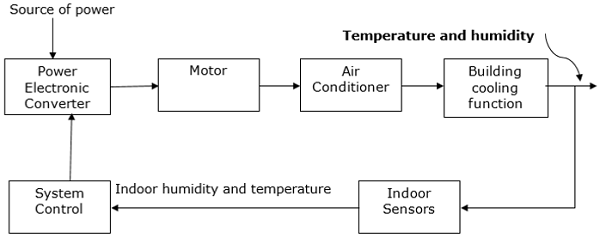
- Power Electronics - Home
- Power Electronics - Introduction
- Power Electronics - Switching Devices
- Linear Circuit Elements
- Power Electronics - Resistor
- Power Electronics - Inductor
- Power Electronics - Power Diode
- Power Diode - Reverse Recovery Characteristics
- Power Electronics - BJT
- Power Electronics - IGBT
- Power Electronics - MOSFET
- Silicon Controlled Rectifier
- SCR - Switching Characteristics
- Power Electronics - TRIAC
- Power Electronics - GTO Thyristor
- Comparision of Power Semiconductor Devices
- Thyristor - Diode Model
- Thyristor - Two Transistor Model
- Thyristor - Turn ON Methods
- Thyristor - Specifications and Ratings
- Solved Example
- Phase Controlled Converters
- Power Electronics - Pulse Converters
- Effect of Source Inductance
- Performance Parameters
- Reactive Power Control of Converters
- Power Electronics - Dual Converters
- Solved Example
- DC to DC Converters
- Power Electronics - Choppers
- Power Electronics - Control Methods
- Resonant Switching
- DC Converters Solved Example
- AC to DC Converters
- Single Phase AC Voltage Controllers
- Power Electronics - Cycloconverters
- Integral Cycle Control
- Power Electronics - Matrix Converters
- Solved Example
- Power Electronics Resources
- Power Electronics - Quick Guide
- Power Electronics - Useful Resources
- Power Electronics - Discussion
Power Electronics - Introduction
Power Electronics refers to the process of controlling the flow of current and voltage and converting it to a form that is suitable for user loads. The most desirable power electronic system is one whose efficiency and reliability is 100%. In Power electronics, our semi conductor devices not only continuous rating but also pulsed ratings.
Take a look at the following block diagram. It shows the components of a Power Electronic system and how they are interlinked.

A power electronic system converts electrical energy from one form to another and ensures the following is achieved −
- Maximum efficiency
- Maximum reliability
- Maximum availability
- Minimum cost
- Least weight
- Small size
Applications of Power Electronics are classified into two types Static Applications and Drive Applications.
Static Applications
This utilizes moving and/or rotating mechanical parts such as welding, heating, cooling, and electro-plating and DC power.
DC Power Supply

Drive Applications
Drive applications have rotating parts such as motors. Examples include compressors, pumps, conveyor belts and air conditioning systems.
Air Conditioning System
Power electronics is extensively used in air conditioners to control elements such as compressors. A schematic diagram that shows how power electronics is used in air conditioners is shown below.

Ordinary Semiconductor Devices Vs Power Semiconductor Devices
Consider a practical wire of 230V, 5A. If we operate the wire beyond the rated voltage and current it will damage. If we wanted to increase the voltage we need to increase the insulation level of the wire.
If we wanted to increase the current we need to increase the cross -sectional area of conductor −
- $\mathrm{R\:=\:\frac{\rho l}{A}}$, where R resistance; resistivity; L length of wire; and A cross-sectional area of wire
- Area of cross section increase, resistance decreases and current increases ($\mathrm{A \uparrow R \downarrow I \uparrow }$).
Following are difference between the ordinary semi-conductor devices and power semiconductor devices −
| Ordinary semi-conductor devices | Power semiconductor devices |
|---|---|
| Low doping concentration | High doping concentration |
| Handles low voltage levels (up to 60 volts) | Handles high voltage levels (up to 1000 volts) |
| Operates at low power | Operates at high power |
| Low current ratings (up to 0.8 A) | High current ratings (up to 40 A) |
Doping is the process of adding some impurity atoms in a pure or (intrinsic) semiconductor so as to increase the conductivity of a semiconductor. Doping can be done in two ways −
- n-type dopant is added, or a pentavalent dopant is added to an intrinsic semiconductor, to form an n-type semiconductor.
- When p-type dopant or a trivalent dopant atom is added to an intrinsic semiconductor, a p-type semiconductor is formed.
Range of doping in Power semi-conductor devices
Following are the doping concentration of the n type and p type region in semi conductor devices −
- n/p type: Ranges between [1016 ~ 1017]/cm3
- n+/p+ type: Ranges up to 1019/cm3
- n-/p- type: Ranges up to 1013/cm3
Selection Criteria to design switches in Power Electronics
Following are the selection criteria for designing switches in Power Electronics −
- High blocking voltage: It represents the OFF state of the switch
- Low condition losses: It represents the ON state of the switch
- Low switching losses: This represent the transient state of the switch
- Thermal limits/ Thermal stability: The semiconductor devices have negative temperature coefficient i.e. the current increase w.r.t the temperature
- Safety factors: The safety factor of voltage/current is 2 or 3
Mechanical switch Vs Power semi-conductor switch
In general, switches are used to control the flow of electrical energy. The mechanical switches are operated mechanically and used for domestic purpose whereas, the power semi-conductor switches are used in power systems which are operated electrically.
Following are the advantages of Power semi-conductor switch over mechanically operated switch −
- Safety is high
- Very fast
- No moving parts(less maintenance)
- High reliability
- Automatic control of power
- Easy to interface with electronic circuit